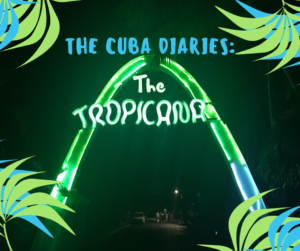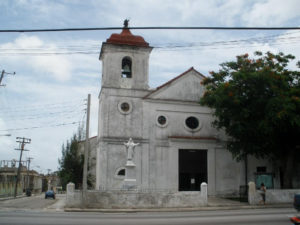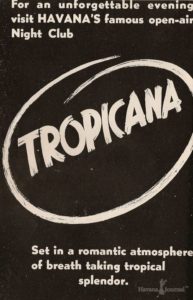 REMEMBERING MARIANAO AND SOME MARIANISTS”, DURING THE SECOND WORLD WAR.
REMEMBERING MARIANAO AND SOME MARIANISTS”, DURING THE SECOND WORLD WAR.
In 1941, the first musical magazine that was set up in the newly opened ‘Tropicana’ cabaret, right where Marianao had been founded more than two centuries before, was the legendary production ‘Congo Pantera’, whose main dancer was the cast. to Luciano “Chano” Pozo, the greatest rumbero that the Cuban nation has given and whose main musical number was the rumba move ‘Parampampín’, by Chano himself. The former inmate of Torrens “hunted” on the stage the Russian “panther” Tania Leskova, dancer of the Russian Ballet of Monte Carlo, to the frantic rhythm that led such legendary tumbadores as Silvestre Méndez and Mongo Santamaría, in a show with choreography by the maestro Russian David Lichine, who combined elements of classical ballet with Afro-Cuban music and in which they also participated, figures such as Rita Montaner and Bola de Nieve.
The famous nightclub had been created by businessmen Víctor de Correa, Rafael Mascaró and Luis Bular in December 1939, on a wooded property that rented Guillermina Pérez Chaumont, known as “Mina”, whose lush gardens provided the perfect natural setting for an outdoor cabaret, while they installed a casino in the old mansion of the estate. Villa Mina was purchased later, in 1949, by the businessman Martin Fox, who commissioned the young architect Max Borges Recio to design a living room under the roof, which at the same time integrated the lush vegetation of the place. The well-known Arcos de Cristal project obtained the Gold Medal of the National College of Architects in 1953 and is one of the masterpieces of Cuban architecture of the 20th century. By then, the entrance of Tropicana was moved to the ancient fountain of the nymphs of the National Casino and the sculptor Rita Longa was commissioned the famous figure of the dancer, symbol of the nightclub.
A few years later, in 1953, Borges would build another similar structure in the Yacht Club, on Marianao Beach, where the recreation centers of the bourgeoisie shared a narrow geography with the so-called “fritas”, timbiriches, cabaretuchos and restaurants that saturated the sidewalk south of Fifth Avenue in the area from today’s eighties streets to beyond the roundabout where the avenue connects with the streets today 120 and 146 (then called Gran Boulevard de Marianao), where in 1950 the town’s Havana Greyhound Kennel Club, which today bears the name of a patriotic baseball pioneer.
Since the 1930s, there had been a proliferation of rustic wooden establishments and zinc roofs where people could eat, drink and dance, and to which humble workers from the area, bohemian intellectuals, risky tourists and North American seafarers from ships anchored in the port, in its last stop of alcoholic and pleasure parties around the city. True school and essential stage for popular musicians, ‘La Playa’ was the cradle of the “fritas music”, a somewhat contemptuous designation (although legitimated and used by Carpentier at a certain moment) that was coined by the Spanish Republican musicologist Adolfo Salazar in 1952. In his precarious scenarios, Benny Moré, Antonio Arcaño, Arsenio Rodríguez, Rolando Valdés, Senén Suárez, Carlos Embale, Tata Güines, a very young Juan Formell with his friend Changuito and dozens of lesser-known figures such as the peasant troubadour Evelio Rodríguez performed. , the “sevillanita” Obdulia Breijos or the forgotten transvestite Musmé.
There the shrill thing sounded, the most rapturous, what really made him enjoy. Groups such as Conjunto Bolero -with its singer Mazacote-, Melodías del 40 and the Afrocubano Ensemble, seasoned the fogozos and fleeting mambo grabs of the volatile couples of one night, in places like ‘El Niche’, ‘Pompiliu’, ‘Mi Bohío ‘,’ Rumba Palace ‘,’ Pennsylvania ‘and’ Los Tres Hermanos’, preamble of early morning wild sex in the many inns that existed in the area, inwards, a little further away from Fifth Avenue.
The district, which contrasted with the clubs on the opposite side, was also the kingdom of El Chori -Silvano Schueg Hechevarría-, exceptional rumbero born in 1900 in Santiago de Cuba and one of the most picturesque characters of the island’s music. El Chori, who had started his career at the dance academy of Mars and Belona, in the center of Havana, had made La Playa his personal stage and played every day in his homonym bass, “La Choricera”, in Los Tres Brothers and occasionally at Rumba Palace. The eccentric Chori, in bizarre attire, scarf and cross neck, mounted a chilling show with music taken from bottles full of water and frying pans and jungle screams, in the style of those who already released his eco Chano in New York -where he had arrived in 1947- during the long breaks that Dizzy Gillespie requested him to make time and entertain the audience in the face of a delay of the musicians or any other setback. The rumbero became roaring lion, tiger juggler, elusive leopard, creating with drums and cries an illusion of mysterious jungle, in the midst of the Bantu or carabalí scenery, of güira and guano.
Chori became famous without ever leaving ‘The Beach’, thanks to the oral chronicle, to the recounts of unforgettable drunkenness and photographs taken by Earl Leaf, famous Beatnik photographer, most famous for documenting the image of Hollywood stars like Marilyn Monroe or Allison Hayes. Leaf, also a musicologist, began his career as a photojournalist for Time and The Saturday Evening Post in “inaccessible” places such as China by Mao Zedong and Zhou Enlai, where he represented the United Press and traveled extensively in Europe and Latin America as correspondent of the organization precursor of the CIA. In 1945 he portrayed the picturesque Chori in his beach cabaret atmosphere. Later, Chinolope, another great visual chronicler of the street, made several photos of the musician and his unmistakable graffiti tag, omnipresent in every corner of Havana, always made with chalk and absurdly perfect typography, work-performance public, ahead pre-basquiática, what would survive a few years after his death in 1974 until it was erased forever by wind and rain.
 RECORDANDO A MARIANAO Y ALGUNOS MARIANENSES”, DURANTE LA SEGUNDA GUERRA MUNDIAL.
RECORDANDO A MARIANAO Y ALGUNOS MARIANENSES”, DURANTE LA SEGUNDA GUERRA MUNDIAL.
En 1941, la primera revista musical que se montó en el recién inaugurado cabaret ‘Tropicana’, justo en el sitio donde había sido fundado Marianao más de dos siglos antes, fue la mítica producción ‘Congo Pantera’, que tenía como principal bailarín del elenco a Luciano “Chano” Pozo, el más grande rumbero que haya dado la nación cubana y cuyo principal número musical era la movida rumba ‘Parampampín’, del propio Chano. El antiguo interno de Torrens “cazaba” en el escenario a la “pantera” rusa Tania Leskova, bailarina del Ballet Ruso de Monte Carlo, al ritmo frenético que propiciaban tumbadores tan legendarios como Silvestre Méndez y Mongo Santamaría, en un espectáculo con coreografía del maestro ruso David Lichine, que combinaba elementos del ballet clásico con la música afrocubana y en el que participaban además, figuras como Rita Montaner y Bola de Nieve.
El famosísimo centro nocturno había sido creado por los empresarios Víctor de Correa, Rafael Mascaró y Luis Bular en diciembre de 1939, en una boscosa propiedad que rentaron a Guillermina Pérez Chaumont, conocida como “Mina”, cuyos lujuriosos jardines proveían el entorno natural perfecto para un cabaret al aire libre, al tiempo que instalaban un casino en la vieja mansión de la finca. Villa Mina fue comprada más tarde, en 1949, por el empresario Martín Fox, quien encargó al joven arquitecto Max Borges Recio el diseño de un salón bajo techo, que a la vez integrara la frondosa vegetación del lugar. El conocido proyecto del salón Arcos de Cristal obtuvo en 1953 la Medalla de Oro del Colegio Nacional de Arquitectos y constituye una de las obras maestras de la arquitectura cubana del siglo XX. Para entonces, la entrada de Tropicana se trasladó a la antigua fuente de las ninfas del Casino Nacional y se encargó a la escultora Rita Longa la afamada figura de la bailarina, símbolo del centro nocturno.
Unos años más tarde, en 1953, Borges levantaría otra estructura parecida en el Club Náutico, en la Playa de Marianao, donde los centros de recreo de la burguesía compartían estrecha geografía con las llamadas “fritas”, timbiriches, cabaretuchos y restaurantes que saturaban la acera sur de la Quinta Avenida en la zona comprendida desde las hoy calles ochentitantos hasta más allá de la rotonda en que la avenida enlaza con las calles hoy 120 y 146 (entonces denominada Gran Boulevard de Marianao), donde en 1950 se inauguró el cinódromo del Havana Greyhound Kennel Club, que hoy lleva nombre de un patriótico pionero del béisbol.
Desde los años treinta, en el área habían proliferado rústicos establecimientos de madera y techo de zinc, donde se podía comer, beber y bailar, y a los que acudían humildes trabajadores de la zona, intelectuales bohemios, turistas arriesgados y marinos norteamericanos de buques fondeados en el puerto, en su última parada de parrandas alcohólicas y de placer por la ciudad. Verdadera escuela y escenario imprescindible de músicos populares, ‘La Playa’ fue la cuna de la “música de fritas”, designación un tanto despectiva (aunque legitimada y usada por Carpentier en determinado momento) que acuñó el musicólogo republicano español Adolfo Salazar en 1952 . En sus precarios escenarios actuaron figuras como Benny Moré, Antonio Arcaño, Arsenio Rodríguez, Rolando Valdés, Senén Suárez, Carlos Embale, Tata Güines, un muy joven Juan Formell con su amigo Changuito y decenas de figuras no tan conocidas como el trovador campesino Evelio Rodríguez, la “sevillanita” Obdulia Breijos o el olvidado travesti Musmé.
Allí sonaba lo estridente, lo más arrebatado, lo que de verdad hacía gozar. Agrupaciones como el Conjunto Bolero —con su cantante Mazacote—, Melodías del 40 y el Conjunto Afrocubano, sazonaban los fogozos y fugaces agarrones de mambo de las volátiles parejas de una noche, en sitios como ‘El Niche’, ‘Pompiliu’, ‘Mi Bohío’, ‘Rumba Palace’, ‘Pennsylvania’ y ‘Los Tres Hermanos’, preámbulo de madrugadas de sexo salvaje en las muchas posadas que existían en la zona, hacia adentro, algo más alejadas de la Quinta Avenida.
El distrito, que contrastaba con los clubes de la acera de enfrente, era además el reino de El Chori —Silvano Schueg Hechevarría—, excepcional rumbero nacido en 1900 en Santiago de Cuba y uno de los personajes más pintorescos de la música de la Isla. El Chori, que había comenzado su carrera en la academia de baile de Marte y Belona, en el centro de La Habana, había hecho de La Playa su escenario personal y tocaba a diario en su bajareque homónimo, “La Choricera”, en Los Tres Hermanos y ocasionalmente en Rumba Palace. El excéntrico Chori, de atuendo estrafalario, pañuelo colorado y cruz al cuello, montaba un show escalofriante con música sacada de botellas llenas de agua y sartenes y gritos selváticos, al estilo de los que ya por entonces soltaba su ecobio Chano en Nueva York —adonde había llegado en 1947— durante los largos breakes que Dizzy Gillespie le solicitaba para hacer tiempo y entretener a la audiencia ante una demora de los músicos o cualquier otro contratiempo. El rumbero se volvía rugiente león, tigre malabarista, leopardo escurridizo, creando con tambores y gritos una ilusión de jungla misteriosa, en medio de la escenografía bantú o carabalí, de güira y guano.
Chori se hizo famoso sin salir nunca de ‘La Playa’, gracias a la crónica oral, a los recuentos de inolvidables borracheras y fotografías tomadas por Earl Leaf, famoso fotógrafo beatnik, más célebre por documentar la imagen de estrellas de Hollywood como Marilyn Monroe o Allison Hayes. Leaf, también musicólogo, inició su carrera como fotorreportero de Time y The Saturday Evening Post en sitios “inaccesibles” como la China de Mao Zedong y Zhou Enlai, donde representaba a la United Press y viajó extensamente por Europa y América Latina como corresponsal del organismo precursor de la CIA. En 1945 retrató al pintoresco Chori en su ambiente de cabaret playero. Más tarde, Chinolope, otro gran cronista visual de la calle, realizó varias fotos del músico y de su inconfundible grafitti tag, omnipresente en cada esquina de La Habana, hecho siempre con tiza y de una tipografía absurdamente perfecta, obra-performance pública, adelantadamente pre-basquiática, qué le sobreviviría unos años tras su muerte en 1974 hasta que fue borrada para siempre por el viento y la lluvia.
Agencies/De Cuba,a lo Cubano/Pedro Beltrán/Excerpts/ Internet Photos/ Arnoldo Varona/ TheCubanHistory.com
THE CUBAN HISTORY, HOLLYWOOD.












